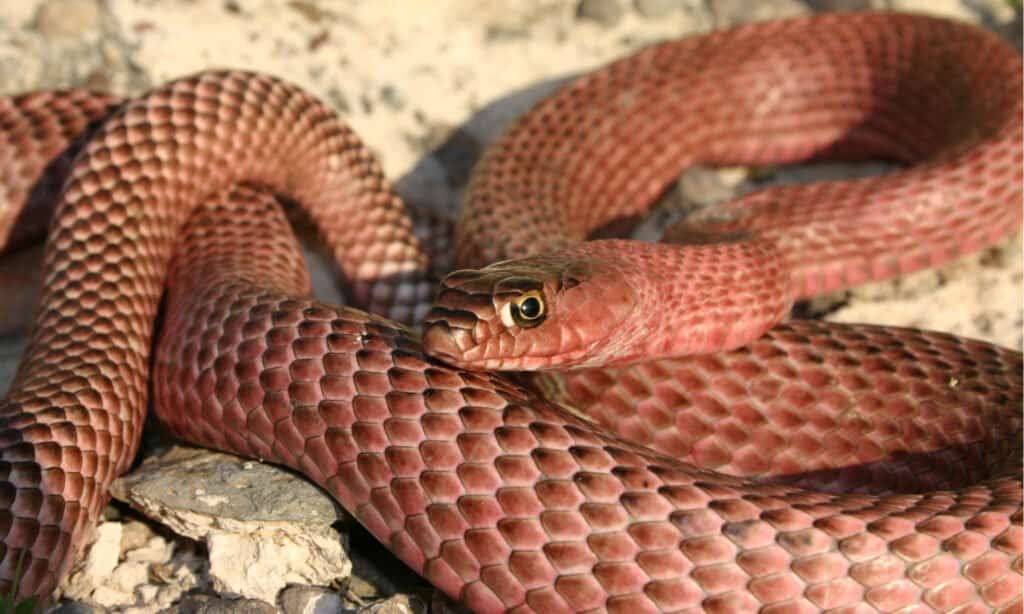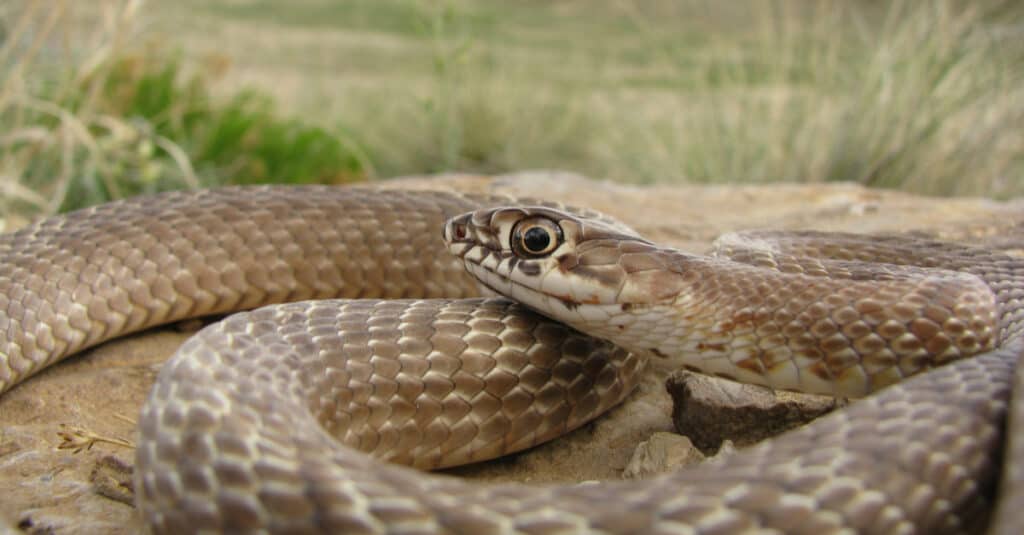Coachwhips and whipsnakes are part of the same genus — Masticophis. They’re long thin snakes that move fast, and to add confusion to the discussion, were lumped in together with North American Racers until recently.
Their taxonomy has waffled back and forth between Coluber and Masticophis genera for the last 100 to 150 years or so, but genetic testing in the early 2000s helped place them in Masticophis for the foreseeable future.
What is a Coachwhip?
Coachwhips are long, thin snakes native to the southern half of the United States and northern Mexico. They’re nonvenomous colubrids, close cousins to North American racers.
These snakes are known for cruising through long grasses with their heads above the grass — a behavior known as “periscoping.” This species is diurnal predators that have excellent eyesight they use to track down their prey — which is anything from rodents to small rattlesnakes.
Although they’re harmless to humans, they bite hard! These snakes don’t relish being picked up by people and often fight back by biting and thrashing around until you release them.
How Big Do Coachwhips Get?
Coachwhips are long and skinny snakes that get long! Some of the biggest snakes even reach seven, or maybe even eight feet long. However, most coachwhips average between four and six feet. Because of their extreme lengths, they’re one of the longest snakes in North America, along with gopher snakes and indigo snakes.
Yet, these are just numbers; how do you get a clear picture of how long snakes can really grow?
Try this: Imagine a snake as big around as a regular garden hose, but as long as a normal six-foot dog leash. That’s an average coachwhip and it’s longer than most rattlesnakes, and even your family dog is probably shorter from nose to tail. However, even the longest don’t get very big around; they probably only weigh about a pound!

Coachwhips tend to match the colors of their habitat and vary widely in color.
©Nathan A Shepard/Shutterstock.com
Types of Coachwhip
Currently, there are two coachwhip species and about six subspecies. Baja California coachwhips used to be included in the subspecies with the others, but that changed with genetic testing. All coachwhips average around 4-6 feet long — it’s their colors and locations that differ. Here they are:
| Snake | Location | Typical Size & Color |
|---|---|---|
| Eastern Coachwhip Masticophis f. flagellum | East Texas, Oklahoma, Arkansas, and Louisiana | 4-6 feet long; some reach 8 feet Usually black front half fades to brown. |
| Sonoran Coachwhip, M. f. cingulum | Mexico and southern Arizona | 4-6 feet long; many exceed 6 feet. Usually pink with dark pink bands |
| Lined Coachwhip, M. f. lineatus | Mexico | 4-6 feet long; usually shades of pink and brown. |
| Red Coachwhip, M. f. piceus | Nevada, southern California, Arizona, and southern Utah | 4-6 feet long; red or pink primarily |
| San Joaquin Coachwhip, M. f. ruddocki | San Joaquin Valley in California | 4-6 feet long |
| Western Coachwhip, M. f. testaceus | Colorado, New Mexico, Texas, Oklahoma, and Mexico | 4-6 feet long; often pink or red |
| Baja California Coachwhip, Masticophis fuliginosus | California and Baja California | 4-6 feet long; two color phases — one dark and one light. |
The Largest Coachwhip Ever Caught
Even though coachwhips are no bigger around than your average garden hose, they’re long. According to an 1888 news article, a farmer in Orland, Florida, shot a 16-footer! However, since no other records of coachwhips reaching that length exist and there aren’t any official measurements, it’s unlikely such a large coachwhip ever lived. The report was probably exaggerated — much like the stories of 40-foot anacondas.
Humans are notoriously awful at estimating the actual length of a snake. It’s a common problem, especially for snake removal experts. So, a two-foot-long juvenile snake becomes a 5-foot-long adult snake, bent on eating your pets.
According to the Florida Museum, the biggest coachwhip ever captured was 102 inches long, or eight and a half feet long. So, imagine a living garden hose that moves at about four miles per hour, raises its head above the grass, and is over two feet longer than a dog leash. Yikes!!
Fortunately, although coachwhips have been the cause of more than a few screams, they’re harmless.

Coachwhip snakes are non-aggressive and non-venomous.
©Joe Farah/Shutterstock.com
Places You’re Most Likely to Encounter Coachwhips
Most coachwhips prefer habits with tall grasses and open canopies. These snakes are generalists and can be found in sand dunes along the beach, in oak scrub, and even in urban environments around people. Coachwhips avoid altercations with people and are great pest control!
This species is really curious and there are stories everywhere about a coachwhip cruising up to someone to check them out, then taking off at light speed in the opposite direction. Because coachwhips hunt primarily during the day, it’s pretty common for people to encounter them.
The photo featured at the top of this post is © Joe Farah/Shutterstock.com
Discover the "Monster" Snake 5X Bigger than an Anaconda
Every day A-Z Animals sends out some of the most incredible facts in the world from our free newsletter. Want to discover the 10 most beautiful snakes in the world, a "snake island" where you're never more than 3 feet from danger, or a "monster" snake 5X larger than an anaconda? Then sign up right now and you'll start receiving our daily newsletter absolutely free.
Thank you for reading! Have some feedback for us? Contact the AZ Animals editorial team.






